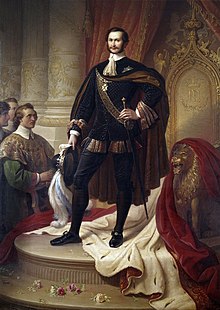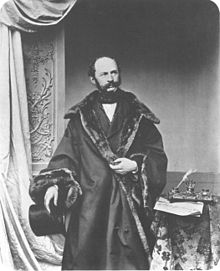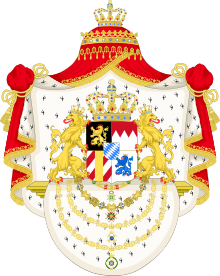Maximilian II of Bavaria
This articleneeds additional citations forverification.(November 2007) |
| Maximilian II | |||||
|---|---|---|---|---|---|
 Maximilian II c. 1860, byFranz Hanfstaengl | |||||
| King of Bavaria | |||||
| Reign | 20 March 1848 –10 March 1864 | ||||
| Predecessor | Ludwig I | ||||
| Successor | Ludwig II | ||||
| Prime Ministers | |||||
| Born | 28 November 1811 Munich,Bavaria | ||||
| Died | 10 March 1864(aged 52) Munich, Bavaria | ||||
| Burial | Theatinerkirche,Munich | ||||
| Spouse | |||||
| Issue | Ludwig II Otto | ||||
| |||||
| House | Wittelsbach | ||||
| Father | Ludwig I of Bavaria | ||||
| Mother | Therese of Saxe-Hildburghausen | ||||
| Religion | Roman Catholicism | ||||
| Signature | |||||
Maximilian II(28 November 1811 – 10 March 1864) reigned asKing of Bavariabetween 1848 and 1864.
Unlike his father,King Ludwig I,"King Max" was very popular and took a greater interest in the business of Government than in personal extravagance. Ascending the throne during theGerman Revolution of 1848,King Maximilian restored stability in his kingdom. The rest of his reign was characterized by attempts to maintain Bavarian independence during the wars of German Unification and to transform his capital city ofMunichinto a cultural and educational city.
Crown Prince[edit]
He was born in Munich and was the eldest son of the Crown Prince of Bavaria (later King Ludwig I) and his wifeTherese of Saxe-Hildburghausen.
After studying atGöttingenand Berlin and travelling in Germany, Italy and Greece, he was introduced by his father into the council of state (1836). From the first, he showed a studious disposition and declared on one occasion that had he not been born in a royal cradle, his choice would have been to become a professor. As crown prince, in the chateau ofHohenschwangaunearFüssen,which he had rebuilt, he gathered about him an intimate society of artists and men of learning and devoted his time to scientific and historical study.[1]TheWittelsbacher Palaiswas built for Maximilian as a Crown Prince Palace in Munich but was completed only when he ascended the throne.
King[edit]

When the abdication of Ludwig I (20 March 1848) called him suddenly to the throne, his choice of ministers promised a liberal regime.[1]
Domestic policy[edit]
In 1849 an uprising in the BavarianPalatinatewas broken down with the support of thePrussian Army.
Though from 1850 onwards his government tended in the direction ofabsolute monarchy,[1]King Maximilian steered a moderate course between the extremes ofclassical liberalism,Prussian-inspired Pan-Germanism, and the so-called "Ultramontanes".
In his attempts to transform Bavaria into a centre of culture, education, and the arts, he enraged conservative Catholics and Protestants by inviting a number of celebrated men of learning (such asGeibel,Liebig,HeyseandSybel) toMunich,regardless of their religious views.[1]
Devoted to his family and his people, the King also financed studies of the art, costumes, dialects and customs of the Bavarian peasantry. That was done to promote a separate national identity against Prussian-inspired Pan-Germanism.
The King was assisted in that by his Personal Private Secretary,Franz Xaver von Schönwerth.A native of theOberpfalzregion of the Bavarian Kingdom, Schonwerth's work collecting the folklore and traditions of his native district won him the admiration of theBrothers Grimmand made him a model for future folklore collectors.
Foreign policy[edit]
Maximilian II responded also to the demands of the people for a united German state by attending theFrankfurt Assemblywhich intended to create such a state. The progress of the 1848 Revolution, however, gave him pause. The king strenuously opposed the unionist plans of theFrankfurt Parliament,refused to recognize the imperial constitution devised by it and assistedAustriain restoring thefederal dietand in carrying out the federal execution inHesse-KasselandHolstein.[1]In the aftermath of the failure of theFrankfurt Assembly,PrussiaandAustriacontinued to debate which monarchy had the inherent right to rule Germany.
The dispute between Austria and theElectoral Princeof Hesse-Kassel (or Hesse-Cassel) was used by Austria and its allies, including Bavaria, to promote the isolation of Prussia in German political affairs. That diplomatic insult almost led to war when Austria, Bavaria and other allies moved troops through Bavaria towards Hesse-Kassel in 1850. However, the Prussian Army backed down and accepted the principle of dual leadership. The event was known as thePunctation of Olmützbut also as the "Humiliation of Olmütz" by Prussia. The event solidified the Bavarian kingdom's alliance with Austria against Prussia.

In his German policy, Maximilian was guided by the desire to maintain the union of the princes.[1]During thecold warfarebetween Austria and Prussia, King Maximilian and his ministers favoured the former, which was a policy enthusiastically supported by the Catholics and the Protestants of the Bavarian Kingdom. Simultaneously, however, the King and his Ministers also attempted to preserve Bavaria's independence by trying to play both powers against each other. That policy continued under his son, King Ludwig II.[2]
In 1863, however, the King supported the project of reform proposed by Austria at theFrankfurt Fürstentag.[1]
Attempts by Austria to reorganise the loose and entirely-decentralisedGerman Confederationwere opposed by Prussia and therefore the other German princes did not act on the reform proposals. The failure of those plans and the attitude of the Austrian Court towards the Confederation and theSchleswig-Holstein Questiondisillusioned King Maximilian. The last days of his reign were spent attempting to deal with the new situation created by the outbreak of the war with Denmark.[3]
Later life[edit]
In the summers of 1849 and 1855, King Maximilian travelled his kingdom. Between 24 June and 27 July 1858, he undertook a journey on foot through his country, which began inLindau.However, because of frequent rain, he repeatedly had to be carried physically.
In government policy, the King repeatedly requested the advice of his ministers and scholarly experts before making a decision, which led to long delays. In addition, King Maximilian often traveled to Italy and Greece, which also led to long delays.
After a brief and unexpected illness, King Maximilian died at Munich on 10 March 1864. He is buried in theTheatinerkirchethere.
Cultural legacy[edit]

Maximilian offeredPaul Heyseand other writers from North Germany large stipends. Hans Christian Andersenvisited "King Max" (as he called him) in his castleStarnberg,and wrote of him as a young, highly amiable man. The King, having read his novels andfairy tales,let Andersen know that he was deeply impressed byThe Improvisatore,En Digters Bazar,The Little MermaidandParadisets Have.During the visit Andersen also readThe Ugly Duckling.[4] Later Andersen visited the King at theSchloss Hohenschwangau.

Next to Hohenschwangau Castle also theHambach Castlewas reconstructed from 1844 for Crown Prince Maximilian byAugust von Voit.In 1849 King Maximilian II instructed the architectEduard Riedelto redesignBerg Castlein neo-gothic style with several towers and a crenellate.
Maximilian II was the principal of theMaximilianstrasseand theBavarian National Museumin Munich. Compared to his father, Maximilian preferred a new architectural style with strong reference to theGothic Revival architecturewhich would combine the best features of historical models combined with then modern building technology. The neo-gothicRoyal MansioninRegensburgwas built for Maximilian 1854–1856, theRoyal MansioninBerchtesgadenand theRoyal VillaonRose Islandalready in 1853. The hiking path inUpper BavariacalledMaximilianswegis named after him, as he made a longer hike in the Bavaria alps in the summer of 1858.[5] TheBavarian Maximilian Order for Science and Artwas first established on 28 November 1853 by King Maximilian II.
Private life and family[edit]

While king, Maximilian was hampered by constant ill health which often compelled him to travel abroad and, when at home, to live much of the time in the countryside. The relationship with his father, who had persisted in his architectural projects even after his abdication, was mostly tense. By his wife,Marie Friederike Franziska Hedwig,daughter ofPrince William of Prussia,who he married in 1842, he had two sons:[3]
- Ludwig II of Bavaria(25 August 1845 – 13 June 1886)[3]
- Otto, King of Bavaria(27 April 1848 – 11 October 1916)[3]
both of whom became king, were declared insane, and deposed.
Honours[edit]

 Kingdom of Bavaria:[6]
Kingdom of Bavaria:[6]
 Württemberg:Grand Cross of theOrder of the Württemberg Crown,1828[7]
Württemberg:Grand Cross of theOrder of the Württemberg Crown,1828[7] Kingdom of Prussia:Knight of theOrder of the Black Eagle,23 January 1831[8]
Kingdom of Prussia:Knight of theOrder of the Black Eagle,23 January 1831[8] Two Sicilies:Knight of theOrder of St. Januarius,1833[9]
Two Sicilies:Knight of theOrder of St. Januarius,1833[9] Grand Duchy of Hesse:Grand Cross of theLudwig Order,18 December 1833[10]
Grand Duchy of Hesse:Grand Cross of theLudwig Order,18 December 1833[10]

 Ernestine duchies:Grand Cross of theSaxe-Ernestine House Order,March 1838[11]
Ernestine duchies:Grand Cross of theSaxe-Ernestine House Order,March 1838[11] Baden:[12]
Baden:[12]
- Knight of theHouse Order of Fidelity,1840
- Grand Cross of theOrder of the Zähringer Lion,1840

 Sweden-Norway:Knight of theRoyal Order of the Seraphim,17 December 1846[13]
Sweden-Norway:Knight of theRoyal Order of the Seraphim,17 December 1846[13] Saxe-Weimar-Eisenach:Grand Cross of theOrder of the White Falcon,5 October 1847[14]
Saxe-Weimar-Eisenach:Grand Cross of theOrder of the White Falcon,5 October 1847[14] Kingdom of Hanover:[15]
Kingdom of Hanover:[15]
- Knight of theOrder of St. George,1847
- Grand Cross of theRoyal Guelphic Order
 Austrian Empire:
Austrian Empire:
- Knight of theOrder of the Golden Fleece,1849[16]
- Grand Cross of theOrder of St. Stephen,1853[17]
 Belgium:Grand Cordon of theOrder of Leopold(military),28 July 1850[18]
Belgium:Grand Cordon of theOrder of Leopold(military),28 July 1850[18] Electorate of Hesse:Knight of theOrder of the Golden Lion,18 October 1852[19]
Electorate of Hesse:Knight of theOrder of the Golden Lion,18 October 1852[19] Oldenburg:Grand Cross with Golden Crown of theHouse and Merit Order of Peter Frederick Louis,24 August 1853[20]
Oldenburg:Grand Cross with Golden Crown of theHouse and Merit Order of Peter Frederick Louis,24 August 1853[20] Duchy of Modena and Reggio:Grand Cross of theOrder of the Eagle of Este,1856[21]
Duchy of Modena and Reggio:Grand Cross of theOrder of the Eagle of Este,1856[21] Grand Duchy of Tuscany:Grand Cross of theOrder of St. Joseph[22]
Grand Duchy of Tuscany:Grand Cross of theOrder of St. Joseph[22]
Ancestry[edit]
References[edit]
- ^abcdefgChisholm 1911,p. 921.
- ^George Windell (1954),The Catholics and German Unity,University of MinnesotaPress. Pages 17–19.
- ^abcdChisholm 1911,p. 922.
- ^Hans Christian Andersen(1996) [1855].Mit Livs Eventyr.Vol. II.Gyldendal.ISBN87-00-24708-1.
- ^"Wandern"(in German).Upper Bavaria tourist association(Tourismusverband München Oberbayern). Archived fromthe originalon 11 December 2005.Retrieved11 March2007.
- ^Hof- und Staatshandbuch des Königreichs Bayern: 1846.Landesamt. 1846. pp.6,10.
- ^Württemberg (1854).Königlich-Württembergisches Hof- und Staats-Handbuch: 1854.Guttenberg. p. 32.
- ^Liste der Ritter des Königlich Preußischen Hohen Ordens vom Schwarzen Adler(1851), "Von Seiner Majestät dem Könige Friedrich Wilhelm III. ernannte Ritter"p. 19
- ^Angelo Scordo,Vicende e personaggi dell'Insigne e reale Ordine di San Gennaro dalla sua fondazione alla fine del Regno delle Due Sicilie(PDF)(in Italian), p. 9, archived fromthe original(PDF)on 4 March 2016
- ^Hof- und Staats-Handbuch des Großherzogtum Hessen(1863), "Großherzogliche Orden und Ehrenzeichen"p. 8
- ^Adreß-Handbuch des Herzogthums Sachsen-Coburg und Gotha(1843), "Herzogliche Sachsen-Ernestinischer Hausorden"p. 5
- ^Hof- und Staats-Handbuch des Großherzogtum Baden(1858), "Großherzogliche Orden"pp. 33,46
- ^Sveriges och Norges statskalender(in Swedish). 1864. p. 421.Retrieved6 January2018– via runeberg.org.
- ^Staatshandbuch für das Großherzogtum Sachsen / Sachsen-Weimar-Eisenach(1859), "Großherzogliche Hausorden"p. 12
- ^Staat Hannover (1859).Hof- und Staatshandbuch für das Königreich Hannover: 1859.Berenberg. pp.36-37,67.
- ^Boettger, T. F."Chevaliers de la Toisón d'Or - Knights of the Golden Fleece".La Confrérie Amicale.Retrieved25 June2019.
- ^"A Szent István Rend tagjai"Archived22 December 2010 at theWayback Machine
- ^"Liste des Membres de l'Ordre de Léopold",Almanach Royal Officiel(in French), 1851, p. 36 – via Archives de Bruxelles
- ^Kurfürstlich Hessisches Hof- und Staatshandbuch(1863), "Kurfürstliche Orden und Ehrenzeichen"p. 16
- ^Hof- und Staatshandbuch des Großherzogtums Oldenburg für 1863,"Der Großherzogliche Haus und Verdienstorden des Herzogs Peter Friedrich Ludwig"p. 34
- ^Almanacco di corte.p. 30.
- ^Almanacco Toscano per l'anno 1855.Stamperia Granducale. 1855. p.274.
Works cited[edit]
- This article incorporates text from a publication now in thepublic domain:Chisholm, Hugh,ed. (1911). "Maximilian II., king of Bavaria".Encyclopædia Britannica.Vol. 17 (11th ed.). Cambridge University Press. pp. 921–922.
